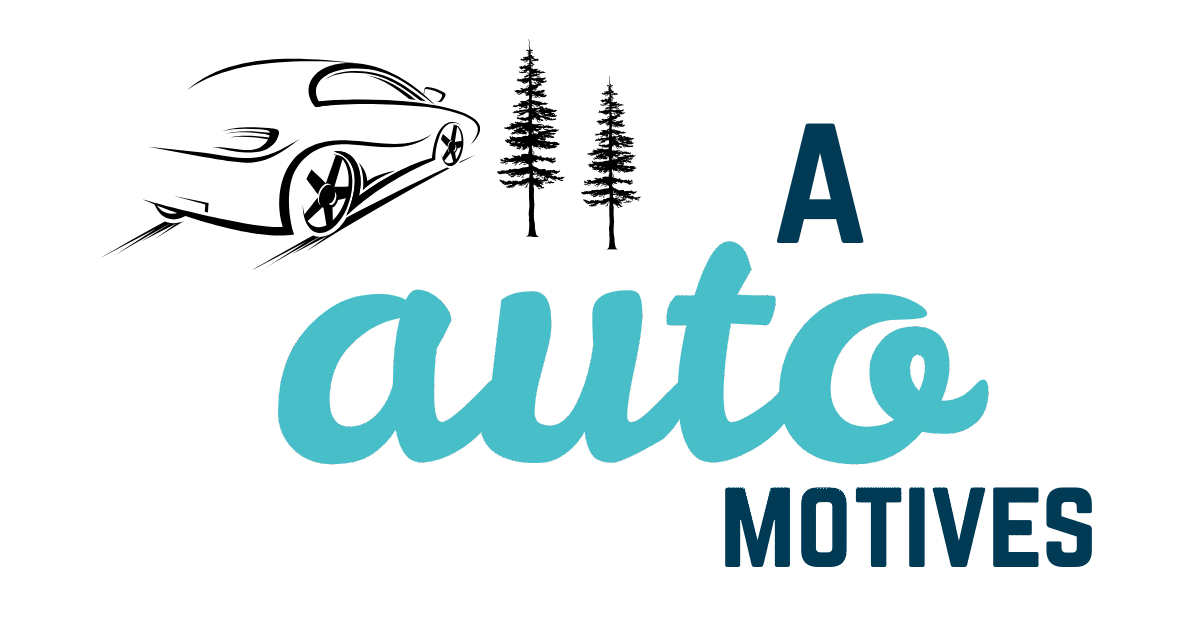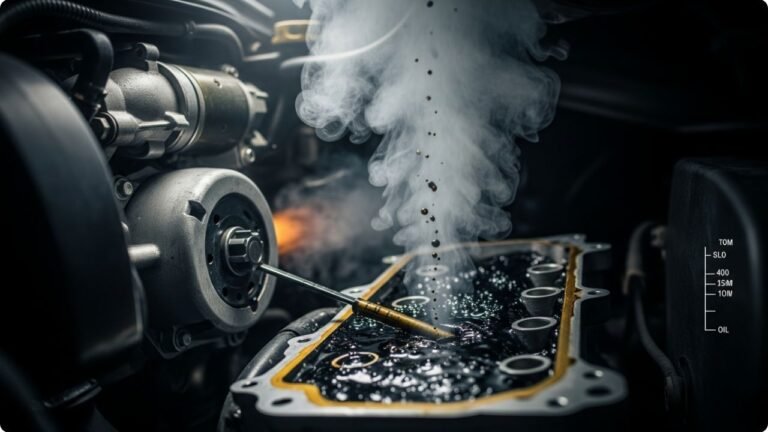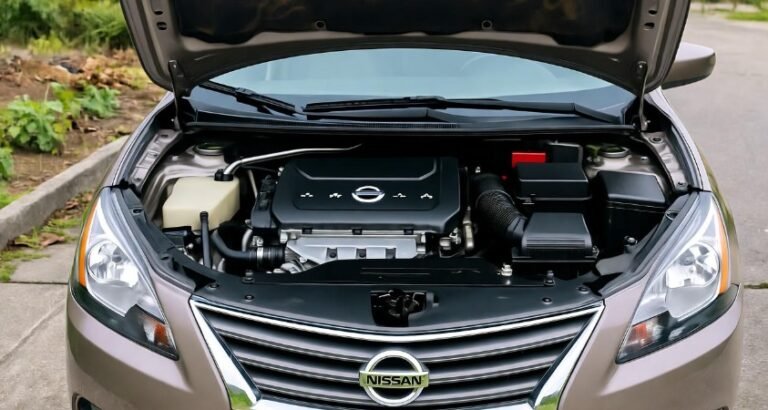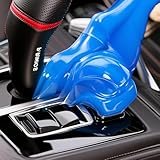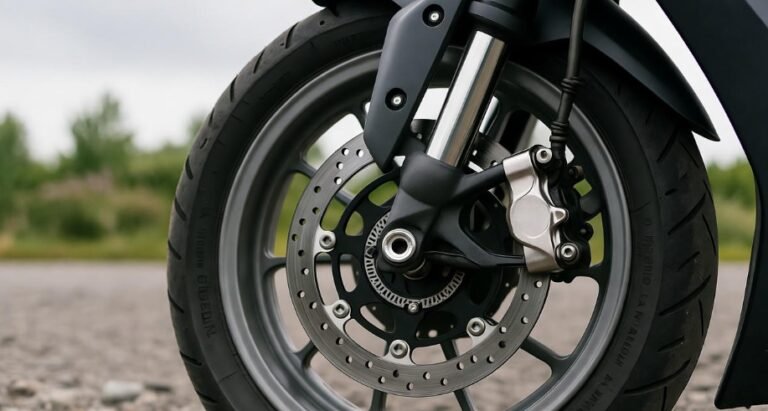Towing a Car with a Motorhome: The Ultimate Guide
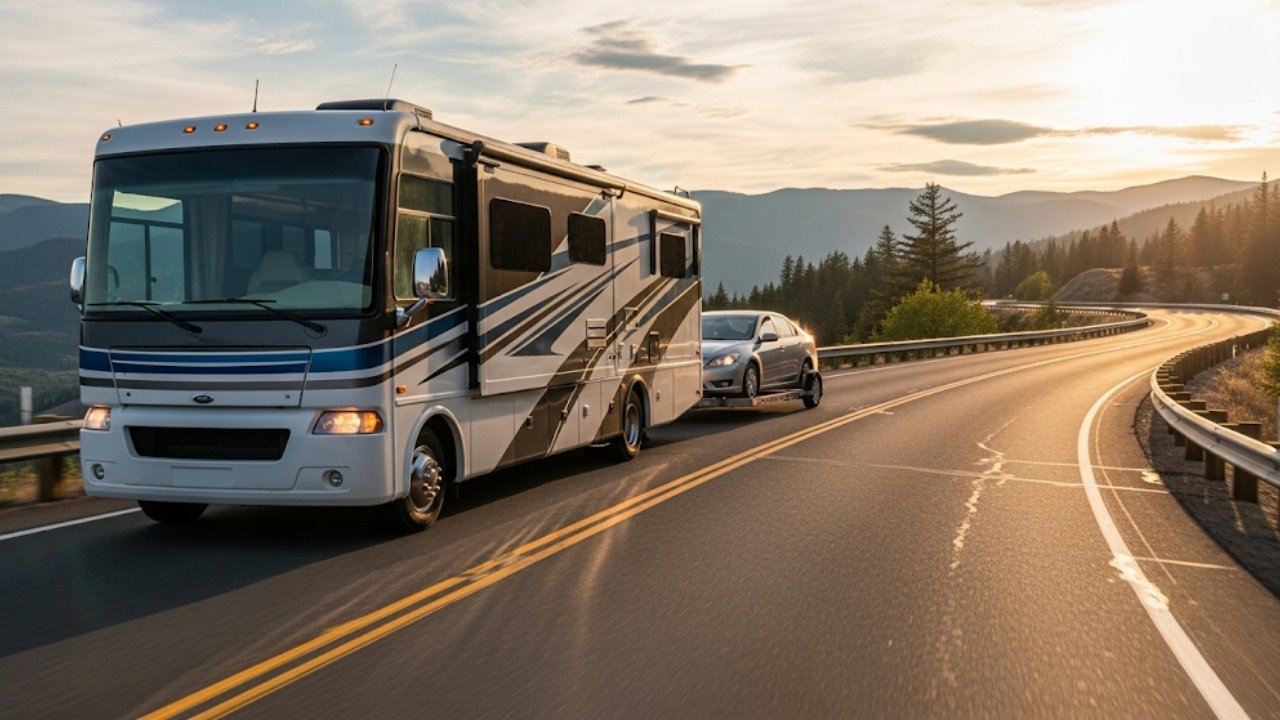
Imagine this: You’re parked in the perfect camping spot in Yellowstone. Birds chirping, trees swaying, your RV perfectly leveled—and suddenly, you realize you need a bottle of ketchup. But driving a 30-foot motorhome into town for one item? No thanks.
That’s where towing a car with a motorhome comes into play. It’s like bringing a trusty sidekick on your adventure—lightweight, agile, and ready to go whenever you need to explore or run errands. Whether it’s sightseeing, grocery runs, or grabbing dinner in a small downtown, having your own vehicle makes life ten times easier.
But let’s be real: towing a car behind your RV isn’t as simple as hitching up and driving off into the sunset. There are choices to make, safety steps to follow, and some rules you just can’t bend. I’ve been there—sweating over tow bar setups, wondering if the car was too heavy, or praying I remembered to release the parking brake.
So let’s dive deep. I’ll walk you through the ins, outs, and oh-no-you-didn’ts of towing a car with a motorhome, all in a tone that feels like we’re chatting over a cup of coffee.
The Three Popular Ways to Tow a Car Behind Your Motorhome
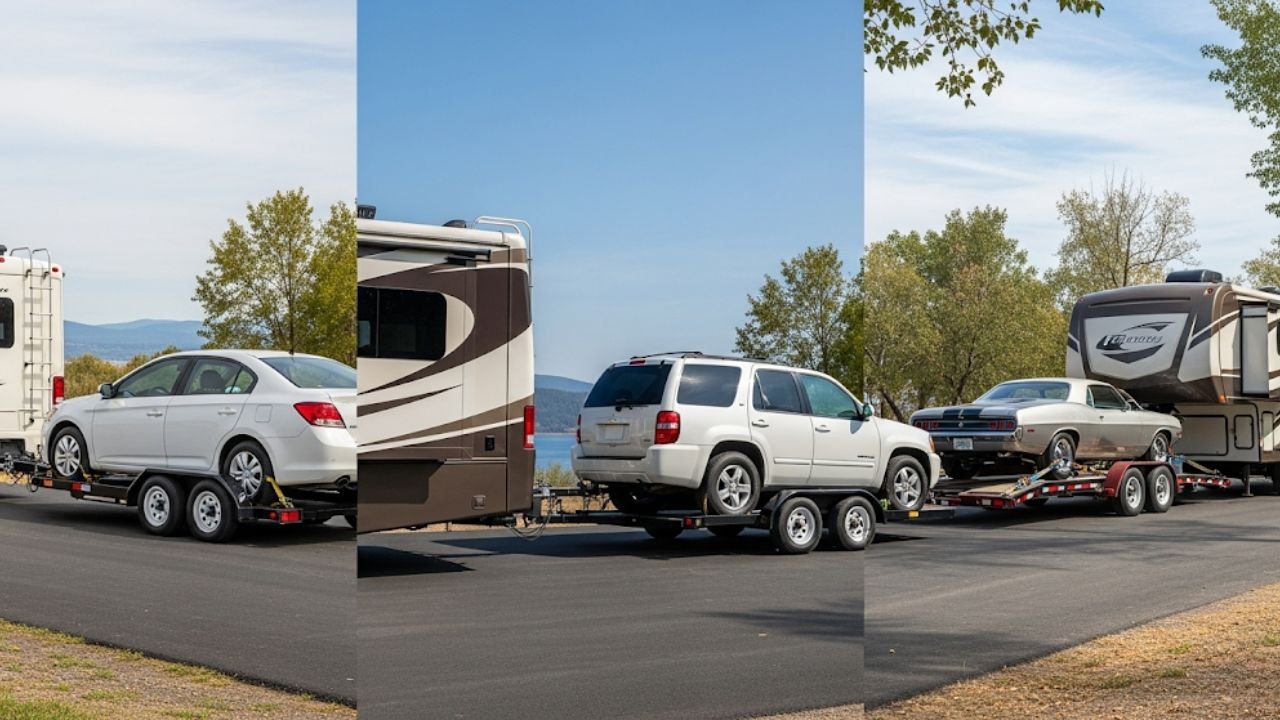
1. Flat Towing (aka Four-Down Towing)
This is the smooth operator of towing. With all four wheels of your car on the ground, it’s as if the car’s casually following you like a loyal puppy.
-
Pros:
-
Quick hookup and detach time
-
Lightweight (no extra trailer weight)
-
Easy to store the towing gear
-
-
Cons:
-
Not all cars can be flat towed
-
May require modifications (like a transmission pump or driveshaft disconnect)
-
2. Tow Dolly Towing
Think of this like piggyback rides for your front wheels. The front tires rest on a small trailer (the dolly), while the rear ones stay on the ground.
-
Pros:
-
Works with more car types
-
Great for front-wheel-drive vehicles
-
-
Cons:
-
Takes up space at the campsite
-
Trickier to load and unload
-
3. Trailer Towing (Car Hauler)
This is the all-in, deluxe version. Your car rides completely off the ground, either on a flatbed or enclosed trailer.
-
Pros:
-
Works with any car
-
Best for long-term or full-time RVers
-
-
Cons:
-
Heavy and large
-
Expensive and needs more storage space
-
Here’s a quick comparison table to make things clearer:
| Towing Method | Setup Difficulty | Vehicle Compatibility | Storage Needs | Best For |
|---|---|---|---|---|
| Flat Towing | Easy | Limited | Minimal | Frequent travel |
| Tow Dolly | Moderate | Moderate | Medium | Occasional users |
| Trailer Towing | Hard | Universal | High | Full-timers or high-value cars |
Choosing the Right Tow Method for Your Setup
Choosing how to tow a car with a motorhome is like picking the right pair of shoes for a road trip. It depends on where you’re going, what you’re bringing, and how you like to travel.
Ask yourself:
-
What kind of car do you have? Some cars just aren’t made to be flat towed. Always check the owner’s manual.
-
How often will you need the towed vehicle? If you plan on daily errands or sightseeing, ease of hookup is key.
-
How much weight can your RV tow? Your rig has limits. Don’t push them.
Pro Tip: Some of my RV friends love the freedom of flat towing. But I personally used a tow dolly when I had my front-wheel-drive sedan. Sure, it took a bit more time to set up, but it gave me peace of mind—and saved my transmission.
What Equipment Do You Need for Towing a Car with a Motorhome?
Okay, so you’ve picked your method. Now let’s talk tools. You wouldn’t bake a cake without the right ingredients, right? Same goes for towing a car with a motorhome. The right gear matters.
Tow Bar or Dolly
Depending on your method, you’ll need a:
-
Tow bar for flat towing
-
Tow dolly for front-wheel-up towing
-
Car trailer for full-load towing
Invest in good quality. Cheap gear might work for a while—but trust me, halfway up a Colorado mountain pass is the wrong time to find out your tow bar’s cracked.
Base Plate Kit
This is the custom mount that attaches to your car’s frame. It’s what connects your car to the tow bar.
-
Must be vehicle-specific
-
Usually requires professional installation
Safety Cables and Breakaway System
These are like insurance. You hope you never need them, but they’re vital.
-
Safety cables connect your car to the RV as a backup if the tow bar fails
-
Breakaway system applies the brakes if your car becomes disconnected
Lighting System
You need brake lights, turn signals, and running lights on your towed car. There are three common solutions:
-
Magnetic lights (temporary setup)
-
Wired system (permanent install)
-
Wireless tow lights (easy plug-and-play)
Important Safety Tips Before Hitting the Road
Let me be your slightly anxious road trip buddy for a second. Safety checks are like the seatbelt of towing a car with a motorhome. Do them every single time, and you’ll thank yourself later.
1. Check Your Towing Capacity
Find your RV’s Gross Combination Weight Rating (GCWR). Subtract your loaded RV’s weight, and that’s the max your car + towing gear can weigh. Don’t go over it.
2. Inspect Tires and Brakes
Check both your RV and towed car. Bald tires or worn brakes? That’s an accident waiting to happen. Also, make sure your car’s parking brake is OFF when towing!
3. Practice Turns and Braking
Your rig will behave differently with an extra 3,000-5,000 pounds behind it. Take a few loops around an empty lot to get the feel.
4. Use Your Mirrors and Camera
Towing changes your blind spots. Invest in extended side mirrors or a rearview camera system for extra peace of mind.
5. Double-Check Everything Before You Leave
Use a checklist:
-
Tow bar/dolly locked
-
Safety cables secured
-
Brake system functional
-
Lights tested
-
Tire pressure okay
I once forgot to plug in my lighting system. A friendly trucker flashed me down at dusk—bless him—and reminded me that being invisible on the highway isn’t a great idea.
Legal Considerations: Stay on the Right Side of the Law
Each state—and even some provinces—has its own set of rules for towing a car with a motorhome. Some require a supplemental braking system. Others limit total combined length.
Here’s what you should always carry:
-
Registration for both vehicles
-
Insurance papers
-
Manuals for your towing system
-
A printed checklist for setup and teardown
And always check:
-
Braking laws for towed vehicles in each state you plan to visit
-
Speed limits—some areas reduce it for vehicles towing
-
Trailer weight limits on bridges and mountain roads
Real Talk: The Emotional Side of Towing
Let’s pause and talk about the feeling of towing. It’s not just about gear and laws. It’s about freedom—and fear.
The first time I towed, I was terrified. I checked the rear camera every five minutes. I stopped at every gas station to inspect the hitch. But over time, that anxiety melted into confidence.
Now, I actually enjoy the process. There’s something deeply satisfying about arriving at a campsite, unhooking your car, and exploring a new place with the ease of a local. It’s freedom on wheels—and that’s what RV life is all about.
Advanced Tips for Towing a Car with a Motorhome Like a Pro
Once you’ve mastered the basics, it’s time to step up your towing game. Trust me, these little adjustments can make your life on the road a whole lot smoother.
1. Use a Tire Pressure Monitoring System (TPMS)
Ever tried guessing if your towed car has a flat tire while cruising at 65 mph? Not fun. A TPMS keeps you updated on tire pressure and temperature in real time. It’s like a health monitor for your tires—and a total stress reducer.
2. Install a Drop Hitch for Level Towing
Towing isn’t just about pulling a car—it’s about doing it evenly. If the tow bar angles up or down too much, you’ll stress the components and risk damage.
Using a drop hitch ensures the tow bar is perfectly level. It might seem like a small tweak, but it makes a huge difference in wear and stability.
3. Grease and Lubricate All Moving Parts
Your tow bar has moving parts. So does your dolly. A bit of regular grease goes a long way in preventing squeaks, jams, and rust.
I make it a habit to carry a small bottle of silicone lubricant and a pair of gloves. Before each trip, a quick squirt on pivot points keeps everything smooth.
4. Consider a Portable Brake Controller
Many RVers love the Brake Buddy or Blue Ox Patriot systems. These portable brake controllers apply pressure to your towed car’s brake when you hit the RV’s brakes.
That means less wear on your motorhome and shorter stopping distances—a win-win for safety.
Common Mistakes People Make When Towing
Even experienced RVers slip up. I’ve learned these the hard way—so you don’t have to.
1. Forgetting to Put the Car in Neutral
This is probably the most infamous mistake. If you don’t shift the car into neutral, you’ll drag the drivetrain—and possibly destroy it.
Pro Tip: Make it a ritual. I put a sticky note on my RV dashboard that says “Neutral? ✅” before I hit the road.
2. Not Double-Checking Connections
Tow bar pins can pop out. Safety cables can come loose. Take two minutes to recheck every connection. One minute now saves hours of heartache later.
3. Ignoring Manufacturer Recommendations
Every car is different. Some need a battery disconnect. Others need a fuse pulled. Don’t wing it—read the manual or check manufacturer forums.
4. Speeding or Braking Too Late
It’s easy to forget that you’re essentially driving a small train. Give yourself more stopping distance. Brake early. Go easy on curves.
Maintenance Matters: Keep Your Tow Setup Road-Ready
Just like your RV, your towing system needs TLC. Here’s a simple monthly maintenance checklist I use to keep everything in tip-top shape.
✅ Monthly Towing Maintenance Checklist:
-
Check tow bar for cracks or bending
-
Inspect safety cables for frays or rust
-
Test lighting system for full function
-
Lubricate all pivot and lock points
-
Examine tire tread and pressure on the towed vehicle
-
Clean base plate connections with a wire brush
Routine care saves you money and hassle. I once ignored a rusty pin until it snapped during a sharp turn in Arizona. Never again.
Helpful Accessories to Make Life Easier
Beyond the core gear, there are gadgets and upgrades that can turn towing from stressful to effortless.
-
Hitch lock – Prevents theft while parked
-
Lighted hitch pin – Makes night hookups a breeze
-
Wireless rearview camera – Keeps an eye on your car at all times
-
Heavy-duty gloves – A must for messy or muddy hookups
-
Wheel chocks – Keep your towed vehicle from rolling while parked
RV Culture: Towing Stories from the Road
When you’re part of the RV community, you pick up stories like souvenirs. I once met a couple in Utah who’d flat towed the same Jeep Wrangler across every national park in the lower 48. Their secret? “Keep it simple. Keep it clean. Never rush hookup.”
Another guy I met in British Columbia towed a Mini Cooper on a dolly—but added solar-powered brake lights and a GoPro facing the rear axle. Genius? Maybe. Overkill? Possibly. But it worked for him.
These stories prove one thing: towing a car with a motorhome isn’t one-size-fits-all. It’s personal. It’s part of your RV identity.
FAQs: Everything You’ve Been Wondering About
1. Can I tow any car behind my motorhome?
Nope. Not all cars are towable. Always check your owner’s manual or the Dinghy Towing Guide to confirm.
2. Do I need a braking system for my towed car?
In most states and provinces, yes—especially if the car weighs over 1,500 pounds. It’s safer and often legally required.
3. What’s the easiest method for beginners?
Tow dollies are beginner-friendly and work with most front-wheel-drive cars. But if your car is flat-towable, that’s even easier once set up.
4. Will towing my car add wear and tear?
If done right, flat towing doesn’t significantly wear your car. But improper towing can damage your transmission, brakes, or suspension.
5. Can I back up while towing?
Unfortunately, no. With a flat tow or dolly, reversing can jackknife your setup. Always unhook if you need to back up significantly.
6. Is towing hard on my RV?
Only if you’re overloaded. Stay within your RV’s towing capacity, use a braking system, and maintain your setup—then your RV should handle it just fine.
7. How much does it cost to get started with towing?
Expect to spend between $1,500–$3,000 for a full setup, including base plate, tow bar, brake system, and installation.
Conclusion: The Freedom is Worth the Effort
Let’s face it—towing a car with a motorhome isn’t always easy. It takes planning, investment, and a little bit of practice. But the freedom it brings is worth every bit of effort.
You’ll explore narrow mountain towns without fear. You’ll grab groceries without moving your whole home. You’ll go off the beaten path, knowing you can always get back with ease.
It’s not just about convenience. It’s about the joy of exploration—the kind that doesn’t stop when you park your rig. So whether you flat tow, dolly tow, or trailer your ride, know this: you’re unlocking a new level of adventure.
And that’s what RV life is all about.
